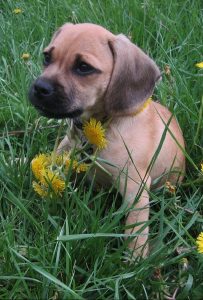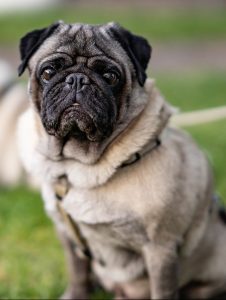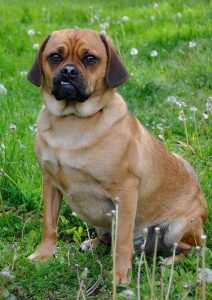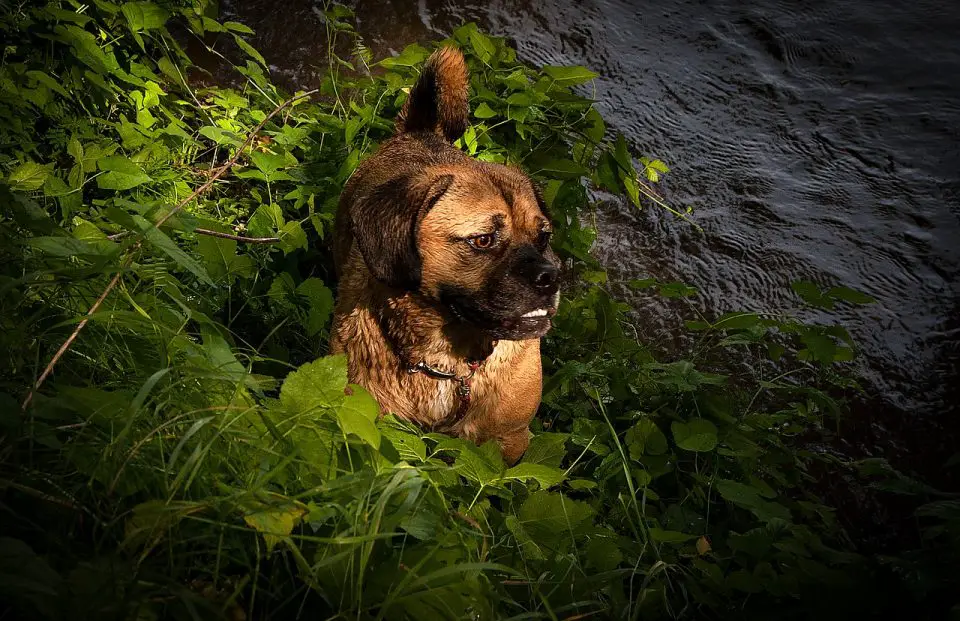A Little About Puggles
Puggles are a relatively new introduction into the dog world so you may never even have heard of one, let along seen one.
What are Puggles?
Although the name sounds like something from a Muppet Movie, this is a crossbreed dog with parentage of Pug and Beagle, hence the name. They are classed as ‘designer’ dogs.
Puggles have become favorites in many households because they are a cute breed.
They have a fun-loving personality and gets on well with kids as well as adults. That makes them great as companion dogs.
Puggles are smart and loving although they can have a stubborn trait especially when training – he may want to do his own thing, instead of taking orders from his human.
Puggles can sometimes be barkers and they would prefer not to be left alone for long periods.
The average Puggle will live between 10-15 years of age, which is the standard for small dogs.
Depending on the genes of the parents Puggles may have either long or short snouts. Shorter snouts may inherit respiratory issues which are common in Pugs.
The first true Puggle was bred by Wallace Haves in the 1980 and he was the first to register the breed with the American Canine Hybrid Club.
Although this was the first time that the breed was registered, there are records of Puggles dating back to early in the 80’s.
By 2000 Puggles had hit the market and were classed as designer dogs. They were mostly sold to people who wanted a ‘different’ dog.
To date, no breed registers or kennel clubs recognizes the Puggle as a dog breed.
Do Puggles Shed?
| The answer is ‘yes.’ Puggles shed, and they shed a lot! Most dogs shed to some degree, but this breed is known as one of the biggest shedders.
You may think that because they are small dogs, there will be less shedding. Do not be conned with this thought, neither should you buy a Puggle from a breeder who tells you they shed lightly. |
Because of the double coat, the dog will shed and because of the hair type, Puggles will shed a lot! You can expect to vacuum every day as well as brush your pooch otherwise you will have a house full of hair.
Because of the amount of hairs on the Puggle the breed sheds heavily.
The average Puggle has over 600 hears per square inch whereas other breeds have just 200 hairs per square inch. The more hairs per area, the more you will find on your floor.
Additionally, because Puggles have a faster growth cycle than other breeds the hairs fall out more frequently.
Short History of Puggles
Puggles were first bred in the US in the 1980’s and were registered with the ACHC at that time. They were commercially available from 2000.
The first Pug came from China and were mostly owned by Emperors. Modern Pugs are thought to have descended from dogs which were imported in the 16th century.
Documents show that William of Orange, in 1572, was warned about approaching Spanish assassins by a Pug, and took one as a pet soon after.
Several Pugs have been found in British history as far back as 1860. The breed became popular throughout Europe and the UK, being first exhibited in 1861.
Pugs were first recognized by the American Kennel Club in 1885.
While the history of the Pug is well documented, the Beagle’s ancestry is not so clear although similar dogs were described in Greek history as far back as 400BC.
It is thought that Beagles may have played a part in rabbit hunting hound breeding which saw them come to England during the Norman Conquest in 1066.
The modern Beagle dates to the 1800’s when they were first bred in Essex and used as hunting dogs.
The Beagles which were then imported to the USA were bred to be smaller so that they could hunt rabbits.
What is a Puggles Coat Like?
 Most Puggles will have fawn, silver/fawn, apricot/fawn and black coats.
Most Puggles will have fawn, silver/fawn, apricot/fawn and black coats.
The coats are double layered with a soft undercoat and a short topcoat. It is because of the double coat that the Puggle sheds a lot.
Occasionally the black Puggle will only have a single coat which will shed a lot less than the double coat.
These are not common in the breed so it is more than likely that your Puggle will have a double coat.
How Much do Puggles Shed?
There is a simple answer to this question. Yes, Puggles shed a lot! While they may not leave as much hair on the furniture, you will find that when you brush your pooch you end up with a mountain of dead hair.
Depending on how many genes are present from the parents, you may find slightly more or less hair. However, they will still shed a lot.
One advantage of the Puggle and their shedding habit is that because the hair is short it is easy to clean up.
Vacuuming the floor once a day or at least every second day will keep hair in the house under control – of a sort.
When do Puggles Shed the Most?
Puggles shed more during the spring and autumn seasons. This is when the coats change to keep the dog warm or cool.
As the new coat comes in, the old coat is pushed out and ends up on the floor. The breed sheds heavily throughout the year.
There are other times when the Puggle sheds heavier such as when they have skin infections or allergies.
Diet plays a large part in keeping the Puggle coat healthy and your vet will be able to advise you in the ideal foods.
How to Combat Puggles Shedding
Realistically, the best and possibly only way to reduce shedding is to brush the Puggle often.
How long should you brush your pooch? There is no set time to do this as you may never see then end of hair on the brush!
A good brushing of around 15 minutes each day will see the hair greatly reduced.
You should focus on the areas where the hair gathers as this will – if not brushed – be a cause of irritation for your pooch.
Areas like the neck, chest, legs, tail, and the back of the head are all areas where you should get the brush to.
Make sure that you brush in the direction of the hair growth, otherwise you may make the dog feel uncomfortable and he will resist further brushing.
The more hair you can brush off, the less you will find in your house. You may want to (weather permitting) brush your dog outside.
If you plan on bathing your dog, then you should brush before the bath to remove dead hairs. After you have dried your dog, you can brush again to get rid of anymore hairs.
An interesting point about bathing is that this may in fact increase the shedding because the massaging process loosens more hair and the shampoo breaks up the natural oils which holds hair in place.
This is the reason why vets do not recommend bathing more than every few weeks.
Equipment Help to Combat Puggles Shedding
 Apart from a good-quality doggie shampoo, there are several other pieces of equipment which you should add to your grooming basket.
Apart from a good-quality doggie shampoo, there are several other pieces of equipment which you should add to your grooming basket.
Dog shampoo
Do not be tempted to use your own shampoo on your Puggle. His pH is different to yours and you may cause the skin to become irritated, and he will shed more.
De-shedding tool
These are great for getting all the dead hair out of the coat. They reach deep into the hair, which is what is needed for the Puggle coat because it is so dense.
Stainless steel de-shedders are a good idea because they will last longer. They are also easy to keep clean and do not stain with age.
A good quality de-shedding tool will not harm to upper coat, as it just deals with the thick undercoat.
Grooming glove
This is very handy for dogs who are apprehensive about being brushed. Your pooch will feel as if he is just being petted and will be inclined to relax as you brush him.
A good quality grooming glove will have over 250 rubber tips to reach deep into the fur and remove the dead hairs. This is an efficient way of brushing your Puggle.
A finishing bristle brush
Once you have removed all the deep-seated hairs, you should brush the upper coat with a bristle brush. This brushing will give the hair a shiny look.
Bristle brushed are also good for removing pieces of dirt and debris which your dog may collect on walks.
If you use products to protect against allergens and dirt, these need to be sprayed onto the hair. A bristle brush will ensure that they are evenly distributed.
Lint roller
For keeping those hairs off the sofa, even after you have vacuumed, or to get a few stray hairs off your clean clothes you may want to invest in a lint roller.
These are very handy for a quick clean up. You can get them as pieces of lint paper which are disposable or as a brush type which can be used many times over.
Are Puggles Considered to be Hypoallergenic?
No dog is truly hypoallergenic although some do come close to this. Puggles are not hypoallergenic.
Never be conned by anyone who wants to sell you a Puggle because they are hypoallergenic. They are not.
Puggle pups may shed less that other pups, but as soon as they reach the age of about 18 months, they will start shedding in true Puggle style.
Do Some Puggles Shed More Than Others?
Yes, some Puggles shed more than others. This depends on the amount of genes that they inherit from their parents.
Black Puggles tend to shed less than other colored dogs and this is because they have a single coat instead of a double coat. Black Puggles are hard to find and can cost more because they shed less.
Healthy Puggles will shed slightly less than those who do not have good diets or have any skin infections.
Health Reasons for Increased Shedding in Puggles
Puggles who are in heat, pregnant or lactating will shed more due to the changes in hormones. You will be pleased to know that they return to their normal shedding pattern after the pups have been weaned.
Excessive hair loss can be caused by conditions such as mange and thyroid issues which the Puggle is prone to.
Allergies can cause your pooch to drop more hair than is normal and the skin condition Alopecia X will also mean more shedding.
A poor diet, or one that is not rich in essential nutrients will cause the dog to drop more hair so you should be sure to include fatty acids in the diet.
Puggles do not deal well with stress and being left on their own for a log time. They may show this by constantly licking a patch until it becomes bald and red.
If you need to leave your dog for extended times, then the Puggle may not be the breed for you. This breed needs its human company – the more, the better!
Final Thoughts
 If you want a dog who makes a delightful companion, is child-friendly and gets along with most people then a Puggle may be a good choice.
If you want a dog who makes a delightful companion, is child-friendly and gets along with most people then a Puggle may be a good choice.
Puggles can adapt to houses or apartments and have no objection to spending their days close to their humans. In fact, they prefer to be close at hand all the time.
The downside of this cute breed is that they shed – a lot. If you need a dog who does not shed, or sheds minimally, then this is not the breed for you.
If you can cope with shedding and hair, then you will find a dog who is loyal and kind. You will have many years of companionship with your Puggle.
